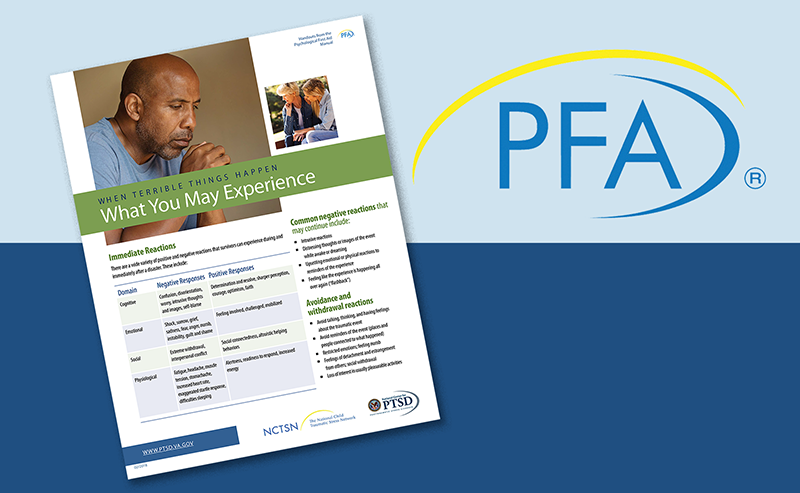PTSD: National Center for PTSD
For Leaders: Helping Employees in the Aftermath of Loss
For Leaders: Helping Employees in the Aftermath of Loss
Loss is a part of life. In most work settings employees will experience the loss of a coworker, friend, significant other, or family member over time. Some will experience more sudden, unexpected, or particularly distressing losses. And there are events when there are collective, shared losses for many employees, such as disaster, which can be natural or human-caused disasters, mass violence events, or public health crises like disease outbreaks, chemical spills, or radiation emergencies.
People Have Varied Responses to Loss
People who are grieving the death of someone close to them have varied responses. As a part of this response, some will desire to get back to work as a respite from grieving, or as a reminder that there is one part of life over which they still have some control. Others may need more time away from work for practical reasons or because they are more overwhelmed by the grief. As a leader, you can help employees handle both responses.
Grieving and Work
The norm following loss is often to leave the grieving person alone for a few days and then hope they will return expediently to work. High work demands, as well as stigma associated with suffering are often the reasons for this approach, particularly in places where employees feel there is an expectation to "keep it together." But this approach can deprive employees of the support they might need. If people who are grieving become isolated as a result of this approach, the natural withdrawal that accompanies mourning is more intense and lasting. It can lead to eroded performance in the short term and diminished commitment and loyalty to the organization in the long term.
Ways to Help a Grieving Person
If you can build a relationship of trust with a grieving person, you can be a strong source of support, helping them feel assisted in their recovery from their grief. The improved workplace functioning that can result may far outweigh the temporary impact of grief on work productivity. Strong time off policies, flexibility, and open conversations make a big difference. Below are a few ways to help.
Be flexible
Employees who are grieving will experience both progressions and regressions in workplace focus and productivity. Regression is performance below a person's typical level of functioning. Acknowledging the loss while lessening demands on them during the regressions helps. Be present and support the person by helping them manage the boundary between themselves and the workplace. If possible, allow remote working, a shift to a less demanding role, or flexible work hours. Check in periodically to discuss how the person is coping and whether further accommodations are needed. Flexibility helps people benefit from the structure of returning to work without being overwhelmed.
Show support
Even simple gestures—especially on the part of leaders—can have a lot of meaning in the aftermath of loss. This should be done in the most fitting way for you, your organizational culture, and the grieving person. Your demonstration of support—a phone call, text, personal visit, sending flowers or a card, attending the memorial service—is a signal that the workplace cares.
Ask questions
If possible, follow the employee's lead regarding what they prefer in terms of time off, support, assistance, and mentoring. You can also ask what they would like you to tell others at work, or how they would like their colleagues to respond when they return.
Inform
Be open with the person about work policies and how flexible they are. Those who are grieving often long for clarity, and clarity around work policies and options can give structure and routine in a time when a person is feeling out of control.
There is no formula for when to return to work; it depends on your work policies and requirements. If the existing policies do not seem sufficient, consider supplementing them with strategies like leave sharing options that allow employees to donate vacation time to those in need, or an employee assistance fund to help workers cover funeral or other expenses. But ultimately, patience and support are what make the difference.
Communicate with coworkers
When an employee is ready to return to work, you can play in important role in preparing coworkers, through communication about the returning employee's wishes and perhaps education about how to deal with grief.
Be patient
Depending on many factors, grief can remain intense for months, and can also flare up years later. The employee may continue to experience periods of confusion, exhaustion, and pain. They may throw themselves into work one moment, and the next moment feel like they can't function at all. If you realize and convey that these grief reactions can be normal for some time after a loss—rather than sign that a person has lost interest in work—you can reduce a good deal of misunderstanding and conflict.
Believe in the person
People can be self-critical when they are grieving, especially those who have been very successful at work. A grieving employee will benefit if you continue to believe in them while not putting too much pressure on them. It requires the capacity to listen and to offer permission to be both a functioning employee and a grief-stricken human being at the same time. It can be a relief for the person to see that you hold them in the same regard as before but can at the same time tailor your expectations as needed. It might also affect the way they view themselves.
Advise and refer
If an employee continues to struggle several months after a loss, it may be helpful to advise them about options for professional help. An inability to sustain regular work duties 6 months after a loss may be a symptom of complicated or prolonged grief. There are effective evidence-based treatments that can reduce suffering and speed up recovery.
Support recovery
An experience of grief can lead to deeper connections with others, greater authenticity, a shift in values, the realization that one is stronger by enduring through losses, and that life is worth living. You can support employees through this process by your interest in what they might be discovering about changes in their life and work. And if an employee is feeling guilt about new ways of feeling and seeing life, listen and support them as they craft a new way forward, speak about your own experiences with adversity or loss, or be open to asking about their experiences over time.
As a manager, you can help grieving employees feel supported as they work towards recovery. Your efforts may have a ripple effect on other employees who see the care you take with the grieving person, help employees remain in their roles, and bring out the best in your workers.
Sources
The following sources informed the suggestions above and offer more in-depth information.
- Berkowitz, S., Bryant, R., Brymer, M., Hamblen, J., Jacobs, A., Layne, C., Macy, R., Osofsky, H., Pynoos, R., Ruzek, J., Steinberg, A., Vernberg, E., & Watson, P. (2010). Skills for Psychological Recovery: Field operations guide. National Center for PTSD and National Child Traumatic Stress Network.
- Bonanno, G. A. (2009). The other side of sadness: What the new science of bereavement tells us about life after loss. Basic Books.
- Jordan, A. H., & Litz, B. T. (2014). Prolonged grief disorder: Diagnostic, assessment, and treatment considerations. Professional Psychology: Research and Practice, 45(3), 180-187. https://doi.org/10.1037/a0036836
- Kliem, S., Lohmann, A., Mößle, T., Kröger, C., Brähler, E., & Kersting, A. (2018). The latent nature of prolonged grief-A taxometric analysis: Results from a representative population sample. Psychiatry Research, 260, 400-405. https://doi.org/10.1016/j.psychres.2017.11.087
- Petriglieri, G., & Maitlis, S. (2019). When a colleague is grieving. Harvard Business Review, 97(4), 116-123.
- Prigerson, H. G., Frank, E., Kasl, S. V., & Reynolds, C. F. (1995). Complicated grief and bereavement-related depression as distinct disorders: Preliminary empirical validation in elderly bereaved spouses. American Journal of Psychiatry, 152(1), 22-30. https://doi.org/10.1176/ajp.152.1.22
- Roulston, A., Clarke, M. J., Donnelly, M., Candy, B., McGaughey, J., Keegan, O., & Duffy, M. (2018). Psychological therapies for major depressive disorder and prolonged grief in bereaved adults. Cochrane Database of Systematic Reviews, Issue 12. Art. No.: CD013237. https://doi.org/10.1002/14651858.CD012327
- Sandberg, S., & Grant, A. (2017). Option B: Facing adversity, building resilience, and finding joy. Knopf.
You May Also Be Interested In


























